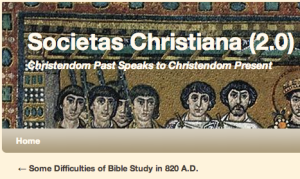 Tim Enloe has re-launched his Societas Christiana blog, a primarily historical treatment of what he calls “the Christian society” of the Middle Ages.
Tim Enloe has re-launched his Societas Christiana blog, a primarily historical treatment of what he calls “the Christian society” of the Middle Ages. Tim is a student of the middle ages and all things Medieval, and I believe that knowing this period will be helpful in all kinds of ways for those interested in learning more about the Reformation and applying its lessons to our own times.
What is “Societas Christiana”? (Part 1): Some Basic Terminology
What is “Societas Christiana”? (Part 2): A Survey of Medieval Diversity
If he gives a theme, it may be found in the first link:
This new iteration of the blog will be dedicated exclusively to re-engagement with issues of Medieval history and culture, with an eye towards what we as Modern Christians can learn from our brethren in the past.
In his first posts, he provides definitions of “Christian society”, “Christian”, and “society”. In the second post, he works through a number of the unique features of “the Middle Ages”, including a broad-brush treatment ranging from patristic questions about how the church should interact with the government and society:
in which apologists and theologians formulated four distinct positions on the locus of authority in Christian society. The four positions held then were: (1) “What has the Emperor to do with the Church?,” (2) “The Church is in the Empire,” (3) “The Empire is in the Church,” and (4) “The Church and Empire are separate, but cooperative.”
The history of the Middle Ages (and indeed, the history of our own time) can be seen as a struggle among those basic kinds of positions. Tim’s summary:
[T]he key point [is] that Medieval thought about societas Christiana was fantastically diverse, and that there is likely much we can learn from it for our own attempts to think about and live out the societal implications of the Christian gospel.

No comments:
Post a Comment